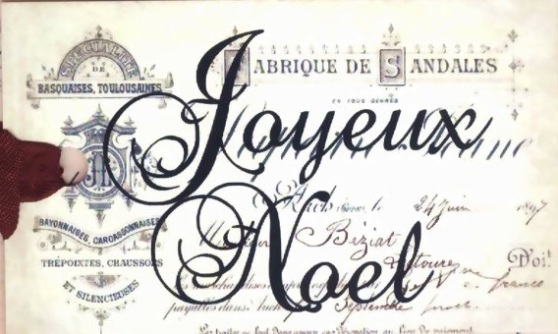It was no secret that Margaret Brown loved France, especially Paris. By 1903, Margaret was fluent in French; she spent a lot of time visiting there and even had an apartment within the city for a time. While we know that she spent a lot of time in Paris, at what time of the year is unknown. With her love of the city, however, she may have been witness to some amazing Christmas traditions which take over Paris.
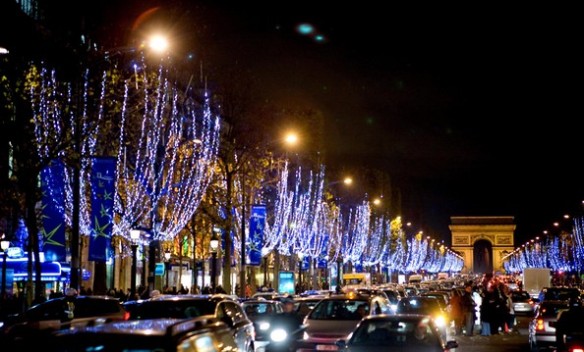
Champs Elysees-Marche de Noël
The city of Paris is taken over by twinkling lights, Christmas markets, and children looking for Pére Noël. When Noël arrives in Paris, the whole city delights in the merrymaking of the season. Signs that Noël will start to soon arrive starts around December 6th with the Feast of Saint Nicholas. Noël itself is a celebration of children, as the French view childhood as a time of innocence and hope to safeguard it as long as possible. For the adults who celebrate the holiday, it is a chance for them to recapture a part of their childhood.
As much as the decorations and merrymaking is a part of the season, flowers offer a wealth of decoration for holiday tables and walls. Flower markets and shops spring up throughout Paris with an overabundance of holiday flowers, including plain and flocked branches of fir, prickly boughs of holly, and a tradition of the ancient Celts (who lived in what is now France), mistletoe. To the Celts, mistletoe represented immortality and could have miraculous powers of hea
Noël is not complete without lavish arrangements of flowers on tables and throughout the house. No hostess would consider the holiday table complete without them. Guests would also bring flowers to the house as a gesture of thanks. Some of the most popular are roses, gladiolas, carnations, and snapdragons. Guests could also bring along potted plants such as red and white poinsettias, azaleas and Christmas begonias. ling. Today, in French culture it is considered a good luck charm. Couples of all ages would try to steal a holiday kiss under the mistletoe.
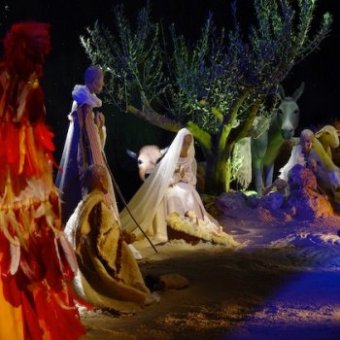
Le crèche de Noël at Norte Dame
Throughout France, you will see one of the most important symbols of a French Christmas-the crèche, or manger scene. Weeks before Christmas, many churches throughout the country will set up their crèches. Many are elaborate and stunning while others are just a grouping of the holy family. The crèche at the Cathedral of the Notre Dame sees over one million visitors a year. Visitors to Notre Dame are encouraged to leave a message of peace in an urn beside the manager. In the home, a small crèche is loved by all the children. It is set up a few days before Christmas, about the same time as the tree. Many of these are antique and passed down from generation to generation. Moss and pine boughs can be place around it for a touch of authenticity. The infant Jesus is not placed into the manger until Christmas Eve, for the Christ Child is born that night.
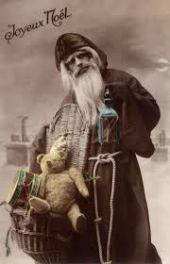
Pére Noël
White lights and silvery garlands adorn the city of Paris as the decorations match those on the city’s most iconic landmark-The Eiffel Tower. The reflection of the lights can be seen in the waters below, only disrupted by the shadows of last minute shoppers. Children wait in anticipations shoes. Pére Noël is unlike the American Santa Claus. He has no reindeer and doesn’t ride in a sleigh. Instead, he is tall and slender with a white beard and long red robe edged with fur. A donkey often accompanies him and he carries a heavy sack filled with toys. He wishes all the children a “Joyeux Noël”. as soon; Pére Noël, will arrive, bringing gifts to place in the children’
On Christmas Eve, French children would leave their shoes near the fireplace. If the home did not have a fireplace, the shoes would be placed near the Christmas tree or crèche. Pére Noël has the entire country of France to visit throughout the night. Many times he might get hungry during his travels so children would often leave a small sack of food for him or even a glass of wine! Some young ones would also leave some food for the donkey as well. Children would wait patiently to see what Pére Noël would leave for them in their shoes.
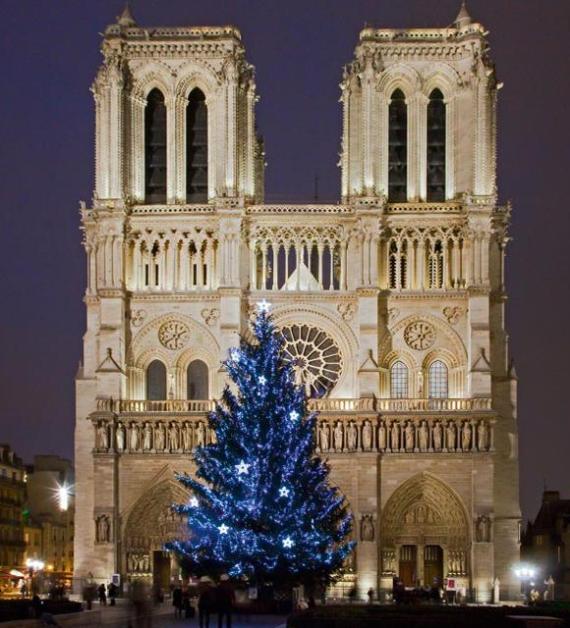
Notre Dame at Christmas
Before attending midnight mass on Christmas Eve, the children of the family would finally be able to place the infant Jesus into the manger on the crèche. While the younger children are tucked firmly in their beds, the older children and adults head to midnight mass at the local cathedral. People of many faiths attend services at some of Paris’s most beautiful churches and cathedrals, including the magnificent Notre Dame. Priests are in all white while those in attendance wear shades of blues and browns. Once the mass ha s ended, attendees start the walk home with the lights of the Eiffel Tower shining on as they head to Réveillon.
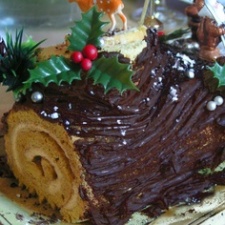
bûche de Noël
Réveillon means “awakening”. This Christmas Eve meal in Paris is celebrated with the same enthusiasm as Americans celebrate New Year’s Eve. Families and friends gather around the table and many times it can last until the early morning. All the family favorites are prepared for the feast which can last up to 15 courses and some of France’s finest wines are offered during toasts. Candles and cloth, perhaps Breton lace, adorn the table. Within the city of Paris, Réveillon is started with oysters in the half shell followed by canapés and pâté de foie gras-a French favorite. Goose and Turkey were followed by many different cheeses and bread with sweet butter continues the feast. It concludes with the always special, always delicious cake: bûche de Noël. The bûche de Noël translates as “Christmas log”, referring to the traditional Yule log burned in centuries past. The bûche de Noël is a thinly rolled sponge cake filled with jam or cream and covered with buttercream icing.
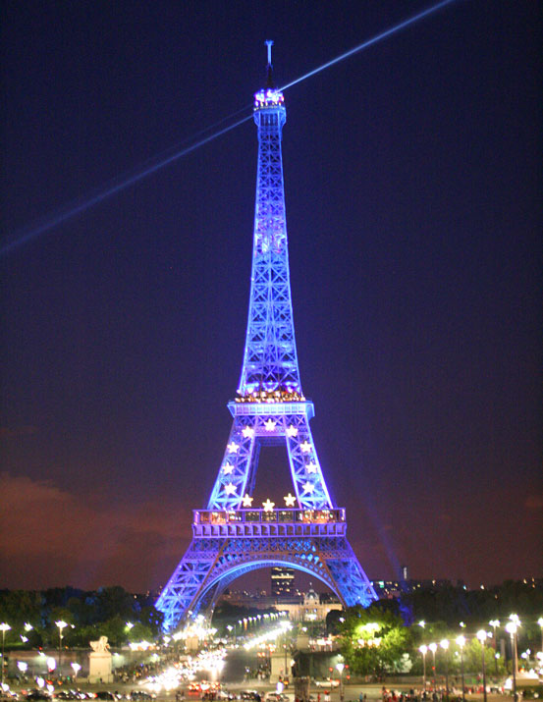
Eiffel Tower decorated for Christmas
Children awake early to see what Pére Noël has left for them in their shoes and that the snack for him is gone. This brings great joy to the children of the family when they see the glass of wine empty and the snack for the donkey has disappeared. The parents sip coffee as children rip into their presents, seeing what Pére Noël has left for them, perhaps even a chocolate wooden shoe! Adults do not rip open presents along with their children. They will exchange their gifts on New Year’s Day.
Noël has come to Paris and captured the hearts of the young and old alike. The celebration of Epiphany ends the season of Noël. The decorations are stored and the people of Paris settle in for the remaining cold months. The joy of the season, however, will linger on in the hearts and minds of all those who celebrated the season. But the joy of the season can be brought back with one single word: Noël!
Research compiled from “Christmas in Paris and the Provinces”
Written by: Jamie Melissa Wilms, Director of Education, Molly Brown House Museum
